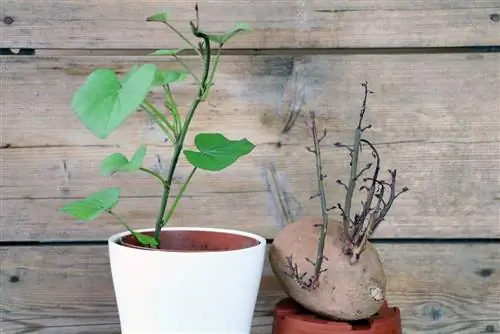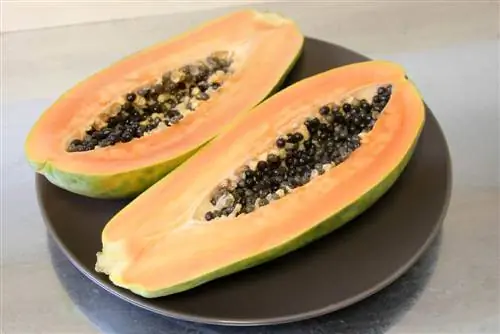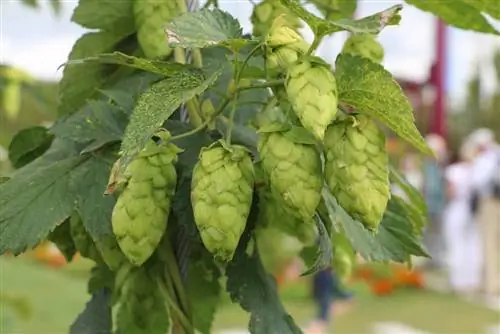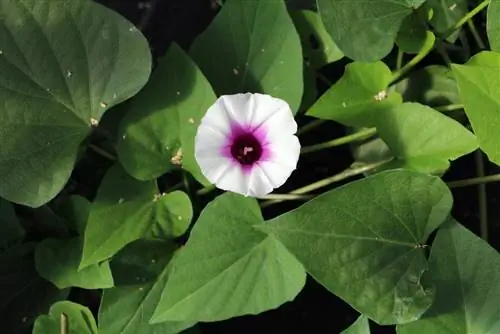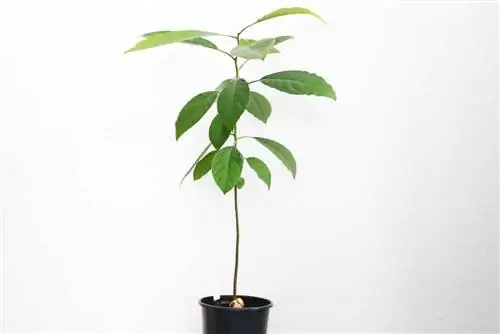- Author admin [email protected].
- Public 2023-12-17 03:39.
- Last modified 2025-01-24 12:45.
These days, the topic of “he althy eating” is becoming more and more important. Many citizens set the tone and trust the organic cultivation of different foods. For example, growing your own fruit and vegetables is highly recommended, as it couldn't be he althier. The financial aspect should not be ignored in this regard.
Growing delicious sweet potatoes
Particular attention is paid here to growing delicious sweet potatoes. Sweet potatoes are becoming increasingly important in our society. These potatoes are not only very he althy, but also versatile. As a rule, these potatoes are cultivated in tropical areas. Under certain conditions, these sweet potatoes also thrive in our latitudes. The sweet potato can be found under the name “Batate” and is one of the most popular potato varieties in the world. This variety has been known in Europe since the 16th century, but was only able to establish itself later due to the northern German climate. As with conventional potato varieties, this potato is irregularly shaped and weighs around 100 g. The special color is a special characteristic and ranges from red to brown.
The high sugar content
Due to the high sugar content, these potatoes taste sweet to spicy. The sweet potato is ideal for home cultivation and can also be used as an ornamental plant. This bulbous plant is often planted in balcony boxes or hanging baskets. This beautiful sight delights the heart of every hobby gardener. The attractive, climbing perennial appears elegant and visually enriches any outdoor area. The beautiful flowers are a pure feast for the eyes. At the end of the gardening season, these plants form a tuber that can be harvested. In order to harvest rich, beautiful sweet potatoes, growing them in a bed is of course essential in order to achieve the best harvest results. The tuber is optimally formed in a bed and can thrive wonderfully under perfect circumstances.
Sweet potatoes are sensitive to cold
However, the sweet potato does not like the cold and stops growing at temperatures below 10 °C. Be careful when there is frost, as the plant will die immediately. The sweet potato should only be planted after the ice saints to avoid unnecessary damage. A sunny to partially shaded spot is optimal and ensures the best growth of these wonderful potatoes. Waterlogging also inhibits growth and should always be avoided. By the end of October at the latest, this delicious sweet potato will be over again, because you won't get any frost at all. In order to achieve the best possible harvest results, pre-grown plants are primarily used. Raising and propagating them is simple and uncomplicated. These plants are now available for purchase in many online portals or mail-order nurseries.
Different variants
Young plants or tubers are available here. Decisions are made individually, depending on needs or practicality. To start with, a few plants are enough to test or try. In March, a tuber can be cut into small pieces and allowed to root in conventional potting soil. An indoor greenhouse is a good idea to ensure an optimal temperature. A temperature of over 18° degrees is required for young plants to develop. The windowsill is the best place for this process. The young plants are then planted in beds at the end of May. Alternatively, buckets or balcony boxes can also be used. When planting in beds, a row spacing of approx.50-60 cm should be respected.
Perfect results
For perfect results, a black mulch film is ideal and promotes root development. This film ensures good soil heating, which has a good effect on growth. In addition, weed formation is minimized and the soil is also moistened. The sweet potato needs a lot of nutrients, which are added through fertilization. The high nutrient requirements require regular watering, especially in long or persistent heat. Pest infestations or diseases rarely occur and are therefore not a problem. When planting in beds and harvesting, it is noticeable that the sweet potato forms numerous daughter tubers. These additional tubers should be harvested in the fall.
Harvesting is simple and straightforward
With the help of a digging fork, harvesting is quick and easy. The valuable tubers are carefully lifted out of the ground and transported in a basket or box. If possible, harvesting should take place in dry weather. These sweet potatoes can be stored dark and dry for many weeks without any loss of quality. The room for storage must not be more than 12-14 degrees. A cool and dark basement room is ideal for storage. Once you have grown and tried these delicious sweet potatoes yourself, you will no longer want to miss out on this enjoyment and comfort, because nothing is tastier and he althier than home-grown food.
One more possibility
Another option is to grow the sweet potato from a vine. To do this, use a sharp knife to cut off a small piece of a sweet potato vine. This piece should be about 15-20 cm long. The cut tendril is placed in a glass of water until small roots form on its own. This process may take a few days and requires some patience. Once the first small roots have formed, these tendrils can be planted. Conventional potting soil is completely sufficient here. These pots then survive the winter in a south-facing window and need to be watered regularly to prevent them from drying out. These plants need around two months to reach the necessary height and strength and to take further cuttings. These processes can now be repeated as often as desired by the new plants. This way you can grow enough plants for the vegetable patch in spring.
Last but not least
Sweet potatoes are a valuable and he althy gift from the home garden, making home cultivation even more attractive. This nutrient-rich potato can be prepared individually and tastes great with many dishes. Whether as a side dish or a main course, the sweet potato rounds off any gourmet dish perfectly and is versatile and interesting because the leaves of this plant can also be eaten.
What you need to know about sweet potatoes
The taste of the sweet potato is, as the name suggests, sweet, but with a slightly spicy note. The tubers can weigh up to a kilogram and can be classified in color from purple-red to brownish to yellow. There are also differences in the flesh of the fruit; it can be pale yellow or deep orange. The red-fleshed batatas are said to have the best aroma and the best cooking properties.
If you want to grow batate in Germany, you only need normal garden soil. This should not be too moist or loose. Humid air, on the other hand, is very good. Propagation occurs from stem or root parts and shoots that can grow from the tuber during storage. It doesn't matter whether you plant the parts vertically or horizontally. You can also simply put a head cutting in a glass of water. After just a few days it forms roots. Sweet potatoes germinate best in a winter garden or greenhouse. Planting time is in April. A planting aid is required because the shoots grow to be several meters long. If temperatures fall below 10°C, the plant dies. Harvest time is in September. In summer you need to water and fertilize sufficiently. The tubers are stored in a cool, dry room, preferably at room temperature. Due to the high water content, they can only be stored to a limited extent.
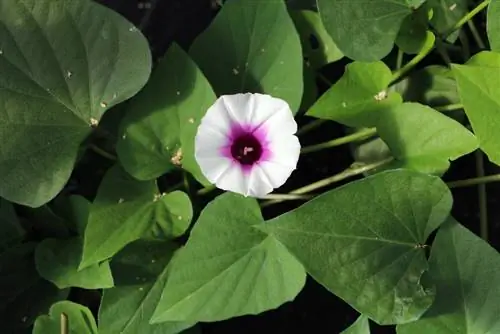
The batate contains a lot of sugar and starch. Particularly noteworthy is the content of beta-carotene and pro-vitamin A. This is the antioxidant with the property of rendering cell-damaging free radicals harmless. Cell damage is often the cause of degenerative diseases such as cancer, rheumatism and osteoarthritis.
The human body can convert beta-carotene into vitamin A. One serving of sweet potatoes (100g) contains twice an adult's daily requirement for beta-carotene. Sweet potatoes are low in calories but high in minerals. Similar to potatoes, the potassium content is high. This is positive for regulating our water balance.
Batate can be prepared in different ways. Peeled, pricked all over with a fork and brushed with oil, they can be cooked in the oven like a baked potato. You can also use them as puree or candied. The sweet potato is particularly tasty when braised in the oven with roast pork or beef. It should taste best freshly fried in the pan. The above-ground, green parts of the sweet potato can be prepared like spinach or chard.
Bata is also used industrially, especially as a basis for the production of flour and starch. But it is also used for starch syrup, spirits, brandy and other alcoholic drinks. The sweet potato is also suitable as wild food.
In the producing countries, batate is an inexpensive food. In Germany, on the other hand, prices are quite high due to high import duties and low demand. The sweet potato is one of the most commonly consumed foods worldwide. It follows just behind rice, wheat, corn and cassava.

